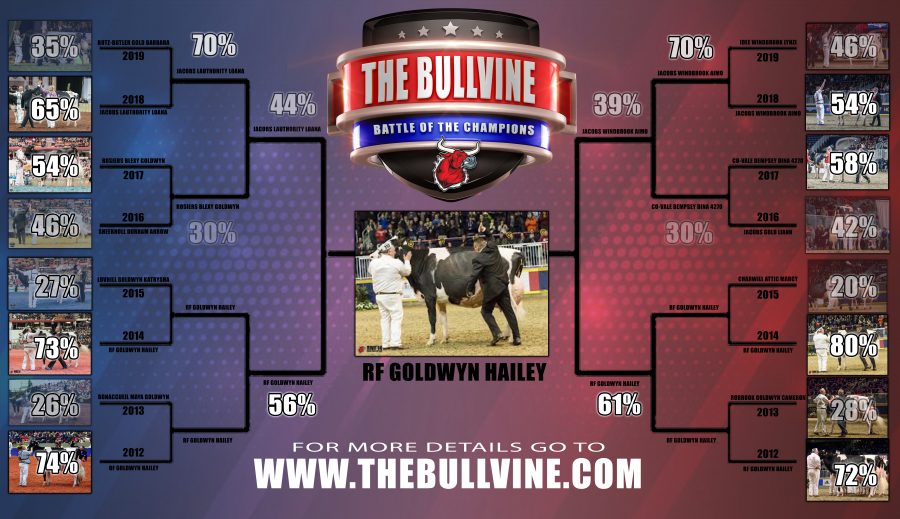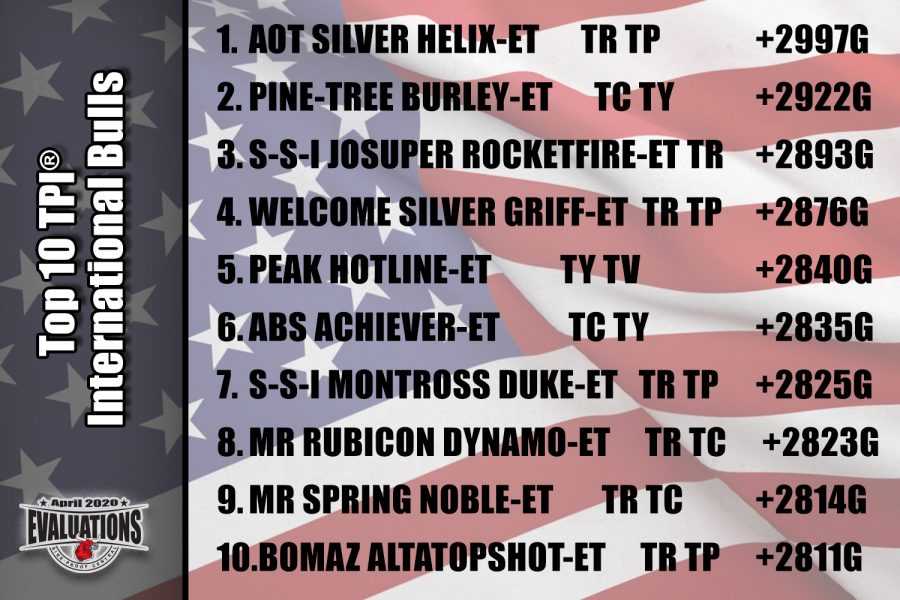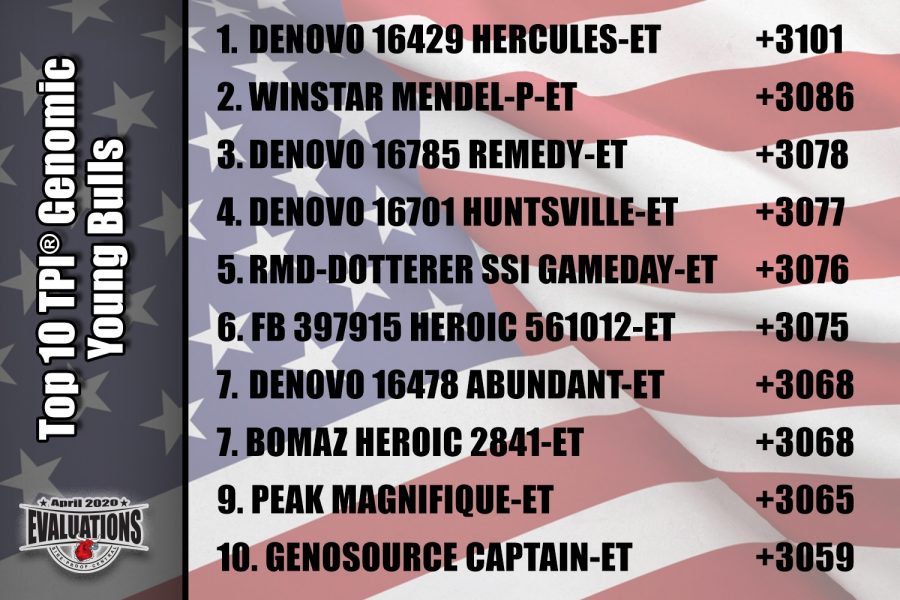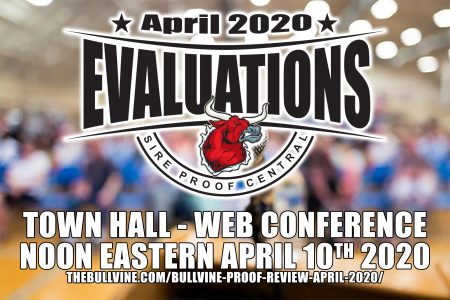
The results are and RF GOLDWYN HAILEY is the Grand Champion of the Bullvine Battle of the Champions – North American Edition.
Have breed society members become too complacent? Have they lost hope? Do they even care about their own futures?
The Bullvine knows and understands that with the current global health crisis and the associated food supply disruptions that there is much on dairy breed society members’ minds about immediate survival and future business.
The outlook for dairy cattle farmer-breeders is often negative. On the Milk House Group and on Facebook there are comments about how breeding companies (formerly called A.I. companies) are taking over from farmer-breeders by running their own breeding herds, by having their breeding lines proprietary to themselves and by producing their own genetic evaluations.
The Bullvine wonders how breeders feel about this because we see that breed society members are not asking more of their breed organizations. More to keep them in the breeding scene. More to help breeders generate revenue from the sale of breeding stock (breed societies once did that). More action to demonstrate a ‘go-to-it’ organization as members plan for the future of their farms. More focused on the future and not repeating the past.
We here at The Bullvine care about helping dairy cattle farmer-breeders to be successful … but … do breeders themselves care?
It should never be too late. However, nothing will change in breed societies, if breed members do not act collectively and demand results.
Here is a partial list of things that breed members and breed societies could do to start down the road to a successful tomorrow:
BREED MEMBERS ACTION
Future Dairy Farming
Expectations of Director
Animal Data
Breed Genes
Breed Priorities
Work with Others
Breed Services
Animal Data
Breed Operations
Breed Genes
Dairy cattle breed societies are in the process of moving from being on life-support to becoming museums.
Without new value-added services, society members will do their voting with their chequebooks. Dairy farmers have been heard to say – “I no longer get value from registration, type classification and historic data files”. So, they will quietly stop registering, having the classifier visit and requesting performance pedigrees.
Is there an opportunity for breed societies to exist in the future? Yes … but only if they change. Performance efficiency, satisfying the consumer, viability and sustainability are today’s prime drivers of that change.
Now is the Moment of Truth. Breed societies have only two options … change or fold!

Get original “Bullvine” content sent straight to your email inbox for free.
While much of the countries attention is focused on battling the Corona-19 Pandemic, the dairy industry temporarily focuses on the April 2020 Holstein Genetic Evaluations.

Topping the proven sires is Aot Silver HELIX, Silver x Supersire x Man-O-Man from the Cookiecutter Mom Halo-ET VG-88 DOM cow family, comes in at +2997 TPI on over >2500 milking daughters. Next on the proven sire list is Pine-TRee Burley at +2922 TPI and +829 NM$. Burley is a Boastful x Altaoak x O-Style from the Jafral Prelude Prissy VG-86 GMD DOM cow family. Rounding out the top proven sires is S-S-I Josuper Rocketfire who is a Josuper x Sterling x Robust from the Creek O Man Tabitha VG-86 GMD DOM cow family at +2893TPI and +776 NM$. See complete list here High Ranking Sire Report

Topping the genomic sire list is DENOVO 16429 HERCULES, a Pine-TRee Heroic-ET from De-Su Frazzled 6984-ET who goes back to the Clear-Echo 822 Ramo 1200-ET TY EX-94 DOM cow family. Hercules has a +3101 TPI and a +993 NM$. 2nd on the genomic sire list is WINSTAR MENDEL-P, who is a Denovo 8084 Entity-ET from Winstar Windfall 4539-ET then Seagull-Bay Roxy Pp-ET. He has a +3086TPI and +908$. Rounding out the top sires is DENOVO 16785 REMEDY, who is a oyal x Medley x Yoder who traces back to the recently deceased Seagull-Bay Miss America and then Ammon-Peachey Shauna-ET EX-92 GMD DOM. He has a +3078TPI and +939 NM$. See complete list here High Ranking TPI® Genomic Young Bulls.
 On the sires over one year of age Genosource CAPTAIN came out as the #1 GTPI sire with no less than +3059 GTPI in combination with +912 NET MERIT (#3 NM$ sire). Captain is a Charl x Sabre x Ahead from the Roylane Shot Mindy 2079-ET cow family. Also, over the 3000 TPI threshold is Sandy-Valley R Conway-ET at +3042 GTPI. Conway is a Renegade x Granite x Draco from the Larcrest Comet-Ets cow family, Rounding out the top sires is Bomaz Top Dog at +3030 GTPI. Top Dog is a Rome x Outsiders x Delta from the Ri-Val-Re Super Nadine-ET VG-87 cow family.
On the sires over one year of age Genosource CAPTAIN came out as the #1 GTPI sire with no less than +3059 GTPI in combination with +912 NET MERIT (#3 NM$ sire). Captain is a Charl x Sabre x Ahead from the Roylane Shot Mindy 2079-ET cow family. Also, over the 3000 TPI threshold is Sandy-Valley R Conway-ET at +3042 GTPI. Conway is a Renegade x Granite x Draco from the Larcrest Comet-Ets cow family, Rounding out the top sires is Bomaz Top Dog at +3030 GTPI. Top Dog is a Rome x Outsiders x Delta from the Ri-Val-Re Super Nadine-ET VG-87 cow family.
On the type list number one PTAT sire is this run the super transmitter Dymentholm Mr Apples Avalanche *RC at +3.84 PTAT. Avalanche is sire or MGS to no less than 4 bulls in the top 10. Second in the list is the former #1 PTAT sire Lindenright MOOVIN *RC at +3.79 PTAT.
US Proof Information
 This round sees four newly proven sires penetrate the elite Top 10 list with three newcomers managing to enter. Top 10 for both LPI and Pro$. The most outstanding achievement this round goes to S‐S‐I Millington Totem‐ET(Millington x Jacey), who grabs #3 LPI and #4 Pro$. The highest newly proven sire for Pro$, in #3 position, is PeakHotline‐ET, who is the highest of the first two proven sons of AltaHotrod in Canada taking #9 for LPI (tied #8 Fat). S‐S‐I Penley All Star‐ET (Penley x Lucid) also achieves Top 10 status for both indexes with a debut at #6 Pro$ and#8 LPI. The fourth newcomer this round that enters Top 10 for Pro$ is Dudoc Stetson P*POC (Superman son out of Dudoc McCutchen Rancune P*POC), who grabs #9 Pro$ and #38 LPI, making him the highest polled sire for Pro$ proven in Canada. Similarly, the fourth newly proven sire this round that enters the Top 10 LPI list is Stantons Actually (Silver son out of Stantons McCutchen 1174 Agree) in #6 spot (#23 Pro$), landing just ahead of his maternal brother, Stantons Alligator‐ET (by Kingboy) who now occupies #7 LPI (#94 Pro$, #2 Conformation).
This round sees four newly proven sires penetrate the elite Top 10 list with three newcomers managing to enter. Top 10 for both LPI and Pro$. The most outstanding achievement this round goes to S‐S‐I Millington Totem‐ET(Millington x Jacey), who grabs #3 LPI and #4 Pro$. The highest newly proven sire for Pro$, in #3 position, is PeakHotline‐ET, who is the highest of the first two proven sons of AltaHotrod in Canada taking #9 for LPI (tied #8 Fat). S‐S‐I Penley All Star‐ET (Penley x Lucid) also achieves Top 10 status for both indexes with a debut at #6 Pro$ and#8 LPI. The fourth newcomer this round that enters Top 10 for Pro$ is Dudoc Stetson P*POC (Superman son out of Dudoc McCutchen Rancune P*POC), who grabs #9 Pro$ and #38 LPI, making him the highest polled sire for Pro$ proven in Canada. Similarly, the fourth newly proven sire this round that enters the Top 10 LPI list is Stantons Actually (Silver son out of Stantons McCutchen 1174 Agree) in #6 spot (#23 Pro$), landing just ahead of his maternal brother, Stantons Alligator‐ET (by Kingboy) who now occupies #7 LPI (#94 Pro$, #2 Conformation).
For the other bulls that rank among the Top 10 LPI this round, they all maintain that status from last December. In fact, Peak AltaMarlon (AltaSpring x O‐Style) stays firm in #1 LPI position (#5 Pro$) and is still closely followed by EDG Rubicon‐ET (Mogul x Robust), who moves up the LPI ranks to grab #2 position but stays solid as the breed leader for Pro$ (tied #1 Fat). Westcoast Randall (Loptimum x Numero Uno) doesn’t budge from his #4 LPI and #8 Pro$ rankings. Climbing slightly to #5 LPI is S‐S‐I Kingpin Phantom‐ET (Kingpin x Supersire), who excels for Pro$ by maintaining his #2 position (#6 Fat, tied #4 Protein). To complete the Top 10 LPI list this round is Holyland Elite Exactly‐ET (Halogen x Mixer) who is forced down the list by the arrival of outstanding newcomers and grabs #10 LPI (#37 Pro$).
On the Pro$ side, this April 2020 release includes the annual update to the Pro$ formula for each breed. With the significant changes in milk pricing in Canada as well as costs of production, the scale of the resulting Pro$ values has widened significantly. This means that the highest animals in each breed experience increases whereas the lowest animals drop even further below the breed average. For the Holstein breed, the average change for the Top 100 Pro$ sires in December is an increase of $371 this round, with the highest increase being $670. The two remaining sires that achieve Top 10 Pro$ status this round and have not already been mentioned are Ronelee Midnight Detour‐ET (Midnight x Mogul) at #7 Pro$ (#13 LPI) and EDG AltaYura‐ET (Cashcoin x Robust) taking#10 Pro$ spot (#122 LPI).
Outside of the newly proven sires already mentioned that achieve Top 10 status this round, there are another dozen of the 90 newcomers that land in the top 35 positions for at least one of the national indexes. Just missing the Top 10 ranking, Boldi V Gymnast makes his debut at #11 LPI (tied #18 Pro$) and is the highest of the first two proven sons of Doorsopen in Canada. Progenesis Seducer (Supershot x Defender) also performs well for both indexes taking #17 Pro$ and #19 LPI positions. Stantons Display‐ET (Silver x Day) hits the scene at #16LPI and tied in #29 Pro$ spot. Another Silver son, OCD Silver Lightwave‐ET, arrives at #23 LPI (#36 Pro$) and Mr SuperContender‐ET (Supershot x Numero Uno) is not far behind tied in #28 LPI position (#48 Pro$). The second newly proven son of Doorsopen in Canada, namely Progenesis Outlast (dam is by AltaOak), makes his debut at #26 Pro$(tied #86 LPI) and he is immediately followed by Westcoast Windmill (Supershot x Doorman) at #27 Pro$ (#59LPI). Two newcomers that do particularly well for fat are Murrayholm Glenhaven Cop‐ET (Emerald x Supersire,#3 Fat, tied at #30 LPI, #78 Pro$) and Siemers Bloomfield‐ET (tied #8 Fat, #33 LPI, #63 Pro$), who becomes the highest of the first two proven sons of Delta in Canada. Grabbing #32 LPI and #51 Pro$ this round is StantonsArchimedes, who becomes one of six proven sons of Stantons McCutchen 1174 Agree among the Top 100 LPI, which also include his full brother, Actually (#6 LPI, #23 Pro$), as well as Alligator (#7 LPI, #94 Pro$) and StantonsAdagio‐P‐ET*POC (highest proven polled sire tied at #26 LPI, #120 Pro$). Dubosquet Emir (Wickham x Man‐O‐Man) also achieves Top 35 status with his first official proof at #34 Pro$ (#65 LPI), which is also the case for Stantons Chief‐ET (High Octane son out of Rockymountain Uno Cheyanne), who arrives taking #35 LPI (#167Pro$).
After Stantons Hot Dollars‐ET (Helix daughter out of Stantons Real Dollars‐ET) took top honours for both GLPIand Pro$ with her first official index last December, she is now forced into the #2 position for both national indexes(tied #6 Fat). Another outstanding cow who is newly indexed this round, namely Midas‐Touch Hot Holy‐ET(Hotline daughter out of AOT Rubicon Happening‐ ET), becomes the new breed queen for both GLPI and Pro$(#5 Fat, #8 Protein). Two other cows achieve Top 10 status for both indexes, namely Benner Octoberfest Jingko(#3 GLPI, #9 Pro$) and Stantons Dollar Helix‐ET (#5 Pro$, #8 GLPI, full sister to Hot Dollars). Each list of Top 10for GLPI and Pro$ also welcomes two newly indexed cows this round. For GLPI, this includes Lindenright Lambda Mocha (dam is Lindenright Rubicon Moofia) at #4 GLPI (#27 Pro$) and Stantons Display Win at #6 GLPI(#47 Pro$, dam is Stantons Last Second Win‐ET). On the Pro$ side, the two cows are Main‐Drag Helix Emmit‐ET (dam is Main‐Drag Rubicon Email) at #4 Pro$ (#17 GLPI, #10 Fat) and Stantons Guarantee Go For Gold (dam is Stantons Bee Desired‐ET) at #8 Pro$ (#126 GLPI).
The Top 10 GLPI list of cows is completed by Claynook May Randall (#5 GLPI, #54 Pro$, dam is ClaynookMoxy Silver), Benner Chief Beejay (#7 GLPI, #146 Pro$, dam is Benner Bookel Burlap), Glenhaven E Gizi (#9GLPI, #34 Pro$, Exactly x Mogul) and Bauvreuil Superhero Kiry (#10 GLPI, #53 Pro$, dam is Bauvreuil RubiconKimi). Similarly, the four cows that complete the Top 10 Pro$ list include Stantons Some Helix‐ET (#3 Pro$, #16GLPI, #3 Fat, dam is Stantons Bee Something‐ET), Stantons Helix Roll‐ET (#6 Pro$, #13 GLPI, #1 Fat, dam is Stantons Just Rolling‐ET), Progenesis Detour Kansas (#7 Pro$, #27 GLPI, dam is Progenesis SupershotKassidy) and Stantons Outlast Oral (#10 Pro$, #48 GLPI, maternal sister to Stantons Guarantee Go For Gold).
Two other newly indexed cows make news this round by joining a group of nine cows that are now tied for #1Conformation at +16, namely Blondin Avalanche Dana (dam is Hahncrest ATW Danica‐ET) and Furnace‐HillCandy Crush‐ET (dam is Butlerview ATW Cheyenne‐ET).
See the International list at Sire Proof Central
Modern cattle breeding is about creating the future not the past. The dairy cattle breeding industry has reached the stage where yield and ideal conformation should no longer collectively receive the majority of the weighting in total merit indexes? In our current indexes the weights assigned to traits are based on historic happenings. The Bullvine asks the dairy cattle breeding industry to re-consider what is needed in future total merit indexes for milk production focused herds.
Here are five reasons triggering the need for change:
Genetics must take these matters into consideration and do its part in creating dairy’s sustainable future.
CDCB has published the base changes (“April 2020: Genetic Base Changes”) that will occur at the time of the publication of the April 2020 genetic indexes. A synopsis the US genetic progress and implications for the future include:
The genetic advancement pattern in Canada is similar to that in the US. Canadian base adjustments occur annually.
In order to assist dairy farmers to adapt to the April base changes and to quickly know the genetic superiority or inferiority of animals, CDCB, Lactanet/CDN, breeding companies, breeds and other improvement organizations need to more widely publish %RK (percentile rank) or use the technique of an average rating being 100 for a trait.
In summary, the genetic merit of dairy animals has improved significantly with the use by breeders of the current total merit indexes (NM$, CM$, JPI, Pro$, TPI, LPI, …). The challenge before the industry is to develop and implement enhanced total merit indexes that will guide animal selection according to future needs.
For herds genomically testing all their breeding animals, they will know the genetic level for all traits and will be able to use the health, fertility and functionality ratings, when mating the heifers and cows.
Herd owners that are not DNA testing the females they are using to produce the next generation can obtain an approximate level of the females’ genetic merit by averaging the merit of the three nearest sires. An example could be a Holstein sire stack of – Delta x Supersire x AltaIota – this sire stack shows superiority for production, above average for conformation, but in the bottom one-third of the Holstein population for health and fertility. So, herds with that sire stack would benefit by using top of the breed sires for health and fertility.
For Jerseys, a sire stack of Harris x Valentino x Iatola would have production but not health, fertility or longevity. For the sire stack of Vivaldi x Joel x Tequila there is type and A2A2 but not production, longevity or mastitis resistance.
A study of the top twenty-five Holstein sires with the most daughters registered with USHolstein in the first half of March 2020 averaged: TPI – 91%RK; NM$ – 85%RK; PL – 66%RK; SCS – 69%RK; and DPR – 37%RK. This shows that purebred Holstein breeders are using TPI and NM$, but are not as concerned about survival, health and fertility when selecting sires. Of these top twenty-five Holstein sires 72% were A2A2, 32% were daughter proven and 6% transmitted the polled gene.
Some factors holding back the genetic evaluations for health, fertility and functionality traits include:
If on-farm data does not reach the national central databases for health, fertility and functionality, dairy farmers can expect to see breeding companies collaborating with cooperating automated herds to capture more of the details. The breeding companies will then develop their own proprietary genetic indexes for ranking their sires.
In addition to adding genetic indexes for traits associated with health, labour and revenue, The Bullvine recommends revisions to weightings in future total merit indexes. For discussion purposes, the following areas and emphasizes are provided:
The Bullvine has three suggestion on what dairy farmers can do to put more emphasis on traits beyond production and type:
Worthy of note is the fact that Holstein and now Jersey breeders have sire indexes for health information on metabolic diseases published by CDCB, Lactanet/CDN and breeding companies.
All dairy farmers need to be making known their future genetic needs when it comes to the genetic merit of their cattle for health, fertility and functionality traits. The industry including breeding companies, bull-breeders, genetic evaluation centers, on-farm data capture organizations and breeds needs to listen and to revised total merit indexes.
The time has arrived where dairy cattle owners need to have more animal genetic information for health, fertility, functionality and survival traits. As well, predictions need to be made on how revenue will be generated from dairy herds in the future and the effect those revenue sources will have on genetic indexing. Now is the time to include the entire lifetime of animals, covering both revenue and costs, in total merit indexes. Now is the time to create new total merit indexes that best serve milk production focused farms. Now is the time!

Get original “Bullvine” content sent straight to your email inbox for free.